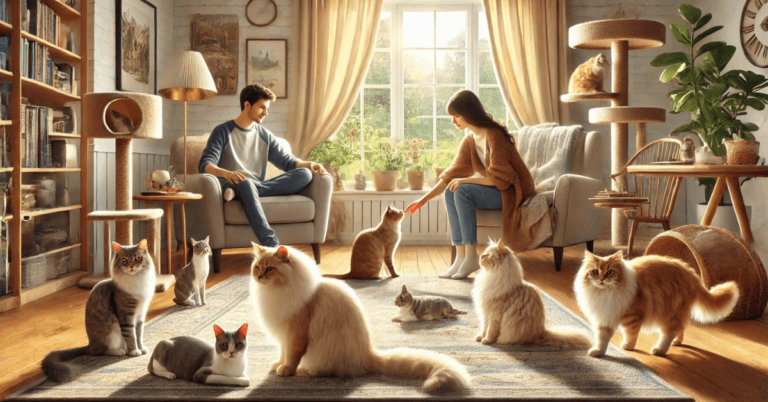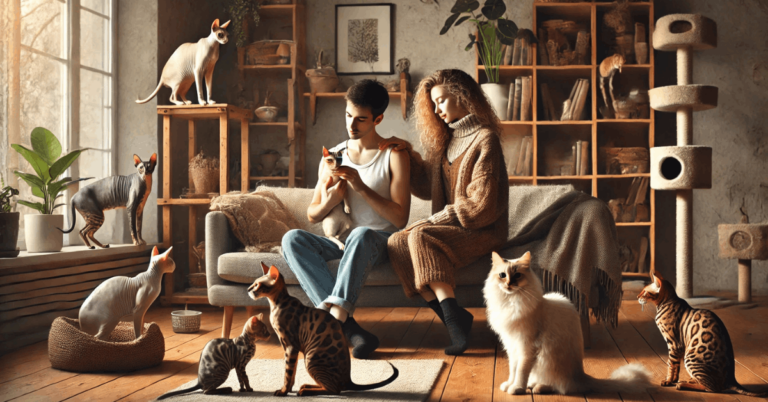The right cat breed can change your life. This guide on the top 5 cat breeds helps you pick the perfect match.
Whether you want playful or calm, there’s a breed for you. Keep reading to find your ideal feline.
Why Cats Are Popular Pets?
Cats are among the most loved pets worldwide. Their independent nature suits busy lifestyles.
They adapt well to small or large living spaces. Low-maintenance needs make them easy to care for.
Many value their quiet, calming presence. Their playful side also strengthens bonds with owners.
Choosing the Perfect Cat: Top 5 Breeds for Every Lifestyle
Finding the right cat breed can make life easier and more enjoyable. This guide highlights the top 5 cat breeds to help you choose the perfect match for your lifestyle.
Siamese
The Siamese breed comes from Thailand, previously known as Siam. They were treasured by royalty for their elegance and grace.
These cats gained global attention in the 19th century. Their distinct look and charm made them popular worldwide.
Physical Features and Personality
Siamese cats have sleek bodies and striking blue eyes. Their short coats with pointed markings make them unique.
They are social and vocal, often seeking interaction. These traits make them fun and lively companions.
Ideal Lifestyle
Siamese cats thrive in homes with lots of attention. They prefer engaging with owners and dislike being left alone. An environment with toys and interaction suits them well. Active households or families are a great match.
Maine Coon: Origin and History
Maine Coons are believed to have originated in the United States. They were popular as farm cats for their hunting skills.
This breed became well-known in the 19th century. Their size and friendly nature make them stand out.
Physical Features and Behavior
Maine Coons are large, with thick, water-resistant coats. Their bushy tails and tufted ears give them a rugged look.
They are gentle and friendly, getting along well with others. Loyal and calm, they are easy to live with.
Best Suited Lifestyle
They fit well in spacious homes or with outdoor access. They adapt to families, including ones with children or pets.
Regular grooming is needed for their long coats. Active yet calm, they enjoy a balanced environment.
Ragdoll: Background and Development
The Ragdoll breed originated in the 1960s in the United States. Ann Baker, a breeder, developed them for their docile nature.
They are known for relaxed behavior and their striking appearance. These traits quickly gained them worldwide popularity.
Key Traits and Temperament
Ragdolls are known for their gentle and loving nature. Here are their key traits:
- Affectionate and love being around people.
- Calm and enjoy lounging indoors.
- Tolerant and good with children or other pets.
- Easygoing, making them adaptable to most homes.
Recommended Lifestyle
These are best suited for quiet, indoor living. They enjoy being around their owners and don’t like being alone for long.
Families or individuals with time for interaction are ideal. Low activity needs make them perfect for apartment living.
Persian
Persians are one of the oldest breeds, believed to have originated in Persia (modern-day Iran). They were prized by royalty for their elegance and charm.
Their popularity spread to Europe in the 17th century. Today, they are admired for their luxurious coats and calm demeanor.
Physical Appearance and Personality
Persians have long, silky fur and a flat face. Their expressive eyes add to their unique look.
They are quiet, affectionate, and love a peaceful home. These cats are friendly but prefer relaxed, less active environments.
Lifestyle Considerations
Persians need regular grooming to maintain their coats. They thrive in calm households with minimal noise or activity.
Indoor living suits them best due to their laid-back nature. Owners should be prepared for their grooming and health needs.
Bengal: Creation and Distinctive Attributes
Bengals were created by crossing domestic cats with the Asian leopard cat. The breed was developed for its exotic appearance and playful nature.
Their spotted or marbled coats resemble wild cats. Bengals are a newer breed, recognized for their energy and intelligence.
Bengal: Personality and Energy Levels
Bengals are highly active and curious. They love exploring their surroundings and playing with toys.
They are social and bond well with their families. Their energy makes them entertaining and lively companions.
Bengal: Ideal Home Environment
Bengals need a spacious home with room to climb and explore. Interactive playtime is essential to keep them stimulated.
Active families or owners with time for engagement are a good match. They may also enjoy safe outdoor spaces or climbing areas.
Additional Considerations
Choosing the right breed requires careful thought about your lifestyle. Each breed has unique needs that may or may not fit your situation.
Factors to Consider
When selecting a breed, keep these factors in mind:
- Allergies: Some breeds are more hypoallergenic than others.
- Time at Home: Breeds like Siamese need constant interaction, while others are more independent.
- Space: Active breeds like Bengals require more room, while Persians thrive in smaller, calm spaces.
Importance of Adoption and Ethical Breeding
Adopting from shelters provides homes to cats in need. Ethical breeders prioritize health and well-being, avoiding overbreeding issues.
Supporting such practices reduces the risk of genetic health problems. Always choose adoption or breeders with a proven ethical reputation.
Health and Care
Understanding the health and care needs of your pet is essential. It helps ensure their long-term well-being and happiness.
Common Health Issues
Here are some health concerns to watch for by breed:
- Siamese: Respiratory and dental issues.
- Maine Coon: Heart problems like hypertrophic cardiomyopathy.
- Persian: Breathing difficulties due to their flat faces.
- Bengal: Prone to digestive disorders.
- Ragdoll: Risk of bladder stones.
Basic Care Needs
Every breed has specific care needs to maintain their health:
- Grooming: Persians need daily brushing; short-haired breeds require less frequent grooming.
- Nutrition: High-quality food supports overall health for all breeds.
- Exercise: Active breeds like Bengals need playtime, while others need moderate activity.
Behavior and Training
Each breed has unique traits that affect their training and behavior. Addressing these properly leads to a better relationship with your pet.
Training Tips for Different Breeds
Tailor training to each breed’s temperament:
- Siamese: Use positive reinforcement for social and vocal tendencies.
- Ragdoll: Focus on building trust and gentle commands.
- Bengal: Offer puzzle toys and climbing areas for mental stimulation.
- Persian: Keep training simple and consistent for their calm demeanor.
- Maine Coon: Encourage interactive play and basic commands.
Managing Common Behavioral Issues
Scratching can be managed with scratching posts and redirection. Excessive meowing often stems from attention needs or hunger.
Provide mental stimulation for active breeds to prevent destructive behavior. Consistency and patience are key to addressing unwanted habits.
Final Thoughts: Choosing the Right Feline
Selecting which feline is perfect for your lifestyle depends on your home, time, and preferences. Each breed has its unique charm and needs.
You can find the ideal companion by considering their traits and your lifestyle. Take time to make an informed choice for a happy and fulfilling bond.


